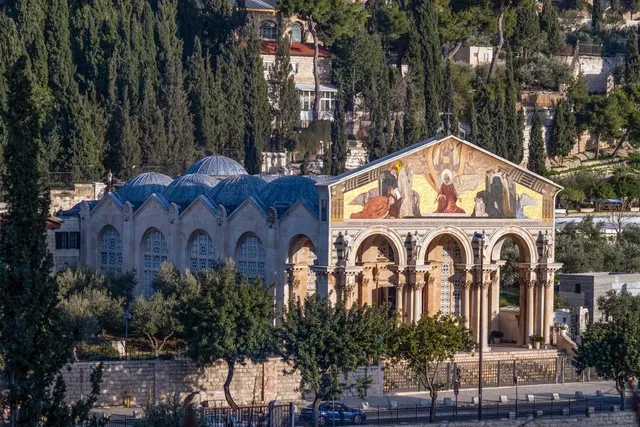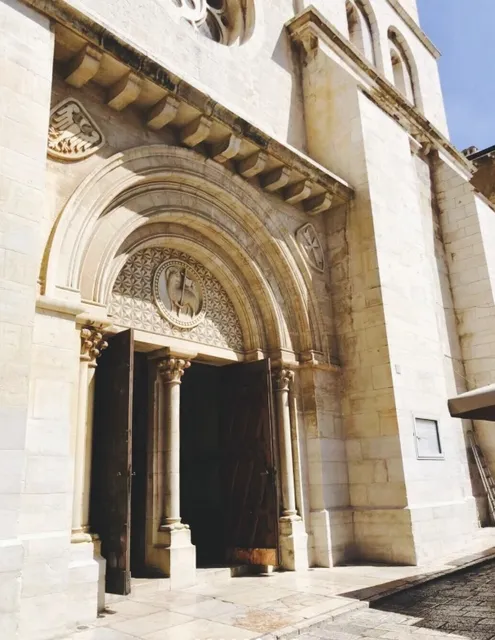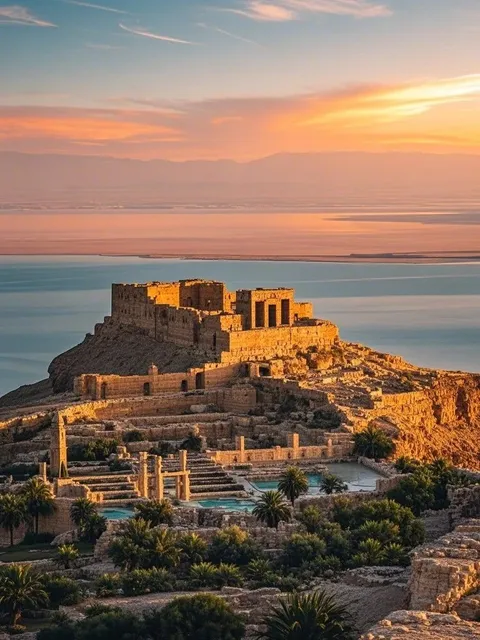In the darkness just before Jerusalem’s dawn, two pairs of feet crunch across the gravel forecourt of the church that houses Jesus’ tomb. A nightbird flying overhead would see two men walking briskly, dressed in warm clothes against the chill air. One, taller and larger, has the air of a weightlifter. He is Adeeb, of the newest generation of Joudehs. In his hand, he holds the 500-year-old key to the Church of the Holy Sepulchre. Wajeeh Nuseibeh, shorter, older, light-haired and tidily dressed, almost dapper, walks with him, hurrying to keep pace. They walk north across the parvis to the massive church door. Here, they will once again carry out their 850-year-old historic duty. Adeeb will hand the thin, long iron key to Nuseibeh. A hatch will open, a ladder will be pushed out. Nuseibeh will climb the ladder and turn the key in its lock, opening the door to the Church of the Holy Sepulchre. The key will go back to Adeeb. Without a word, the two Muslim men whose families have guarded the doors of Christianity's holiest church for centuries will return to their homes, perhaps to resume their interrupted sleep. I spent 7 days in the old walled city of Jerusalem, waiting to find a family that could recall its own history back to the days of the legendary Ottoman Emperor Saladin. I found my man on my fifth day, when I stepped into the gravelly forecourt of the shrine at the centre of Christendom: the Church of the Holy Sepulchre. It was a medley of architectural styles imposed by different Christian monarchs. The acoustics of its dark interior magnified and distorted whispers and the shuffling of feet. At the church's door, over 800 years old and nearly 20 feet tall, stretched a long line of tourists waited to enter. As I watched, it began to move. A ferret-faced fellow was laboriously swinging it to a half-shut position, ostensibly to regulate the throng. Because of his vaguely Levantine looks, I approached to ask him if he was a Church employee. “No,” he said briefly. “I am Wajeeh Nuseibeh.” As though anticipating my next question, he added, “I am allowed. To handle this door.” “By who?” “By al-Malik al-Nasir-i-Salah al-Din al-Ayyoubi,” he said importantly. Salah al-Din. The Emperor Saladin. Over the next hour, I heard the story of Nuseibeh's unusual legacy from a Sultan.
History has teased Nuseibeh by allowing him to open and shut the doors of Christianity’s church every morning and evening, but alas, he may not keep the keys. That honor belongs to another Jerusalem family, the Joudehs. After trouncing Richard the Lionhearted in battle, Saladin was concerned that fellow Muslims might destroy the church and build a mosque in its place, but also wanted to keeping the peace between the various factions that claimed the church, including the Roman Catholic, Greek Orthodox, Armenian Orthodox, Syrian Orthodox, Ethiopian Orthodox and Coptic Orthodox denominations. He issued a farman or royal decree entrusting the church's keys to the Joudehs, a high-ranking and widely respected Muslim family. The Joudehs cherished the farman but felt that climbing a ladder to unlock the door every morning was beneath their status. Where were the Nuseibehs at the time? “My ancestors fled Jerusalem when the Crusaders attacked in 1099." Nuseibeh replied sheepishly. "We hid in Boreen, our village in Nabulus. When we returned, the key was already with the Joudehs. The Sultan said we’d have to open and close the doors. We are proud to carry out that duty.”
In a world where religions are pitted against each other, the centuries-old peace between Muslims and Christians in Jerusalem is a beacon pointing at how things could be. Archbishop Atallah Hannah, Greek Orthodox Patriarchate, puts it succinctly: "In this Holy Land, we are one people, one family, Muslims and...
Read moreThe Church of the Holy Sepulchre in the Old City is one of the holiest sites in the Christian World and essential sightseeing for pilgrims and many others who visit Jerusalem.
Opening hours are 5am to 9pm daily with reduced hours during winter months. Given the importance of this building, expect crowds regardless of what time you visit. We visited several times during our recent trip to Jerusalem and found it much more peaceful around 6 to 6.30am before the larger crowds descended upon the church.
Historically, the church has long been identified as the location of where Christ was crucified and is where you can visit the Tomb of Christ. During his time, this location was just outside the city walls of Jerusalem. However, the area is now referred to as the Christian Quarter and is within the city walls.
The Tomb of Christ is located in the Rotunda, which is an early 19th century structure. The tomb itself is located within an ornate shrine which dates back to the same time period. There are services and ceremony held at the shrine during various times of the day. Expect long queues for entry. Inside the shrine you will be able to see and touch the rock-hewn tomb of Christ.
There are other impressive areas within the church to visit beyond Christ's Tomb, including the Stone of the Unction which rests just within the main entrance into the church. This is the symbolic location for where it is believed that Christ's body was wrapped after his death. You will see an early 19th century stone and hanging incense lamps. Behind the stone is a lovely mosaic scene that is worth viewing.
Further points of interest include St. Helen's Chapel. Look for the carvings of crosses in the wall near the staircase to this chapel. These have been left by pilgrims through the centuries, some potentially dating back to the Crusader period.
You can also see the small Chapel of Adam which is built around the rock of Golgotha. You can see a noticeable crack in the rock, believed to have been caused by an earthquake that followed the death of Christ.
Two upstairs chapels above Golgotha are very much worth visiting as well. Here you see a Roman Catholic chapel with delightful mosaic decor as well as a Greek Orthodox chapel. There is a hole in the ground in front of the altar where you can reach within and touch the Rock.
For those intending to visit the Church of the Holy Sepulchre as a conclusion for their Via Dolorosa - tracing the last stops of Christ experience, this is where you find Stations 10-14. The two mentioned chapels just above are Stations 10-12 while the Stone of Unction and the Tomb of Christ represent Stations 13 and 14.
In the end, Christian pilgrims have been coming to Jerusalem for many centuries with the Church of the Holy Sepulchre being a centre focus of such journeys. It is a truly special place for believers and equally impressive for historians or anyone with interest in architecture, art, religious studies and humanities, making this church essential sightseeing...
Read moreThe Church of the Holy Sepulchre.If you want to write a review about Church of-the Holy Sepulchre on Trip Adviser and enter this name it will not lead you to desired location. You may search Church of the Holy Sepulchre on Trip Adviser till cows come home still you will not find one of the holiest place of Christianity which is listed as "Eglise du Saint-Sepulchre" on Trip Adviser. Though it means one and the same place, I feel it should be listed in English language which is the most widely spoken and understood language on the earth. The Church of the Holy Sepulchre is considered as the holiest place on earth by Christians because according to traditions dating back to at least the fourth century, they believe this as the place where Jesus Christ was crucified, his dead body taken down from the Cross, anointed on the rock/ stone and lowered in the grave. And last but not the least the place of resurrection of Jesus Christ. All this also has resulted in last five stations of the Way of the cross being located in The Church of the Holy Sepulchre.As you enter the church you are greeted with a sight of place crowded, packed with hundreds of people. Many of them devote Christians on a mission of pilgrimage and equal number of tourist of all faiths on the face of the earth. The crowds, the colourful profusion of tapestries, paintings, mosaics, hundreds of decorative lamps hanging fro many vanities of attachments put up by various sects of Christianity, present a bewildering picture of orderly chaos !This is because the various segments of the church are claimed by and belong to and shared by different sects, generally called denominations of Roman-Catholic, Greek Orthodox and Armenian Apostolic, and also by the Coptic Orthodox, Syriac Orthodox and Ethiopian Orthodox. This has resulted in multiplicity of chapels at almost everyplace where some event had taken place. There are astounding number of 30-plus chapels and worship spaces. All with profusion of devotional ornamentation of several Christian rites. For example tomb of Christ is in the aedicule at the same time it is believed to be in another different place at the end of a dark, narrow tunnel. Going around the church is equally confusing and feels like going through a maze.This is due to the crowds where at times you do not know where you are as you are carried by the flow and because of twisting , climbing, descending path and staircases necessitated by different architectural styles, confined and limited space due to large number of events having taken place in a limited area.By the time even a non Christian visitor leaves Church of the Holy Sepulchre he is overpowered by sense of history and the orderly confusion prevailing at the place so revered...
Read more


